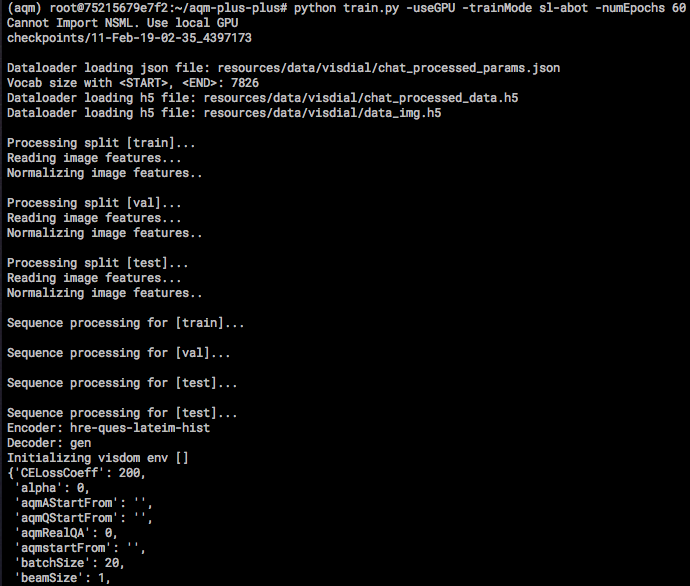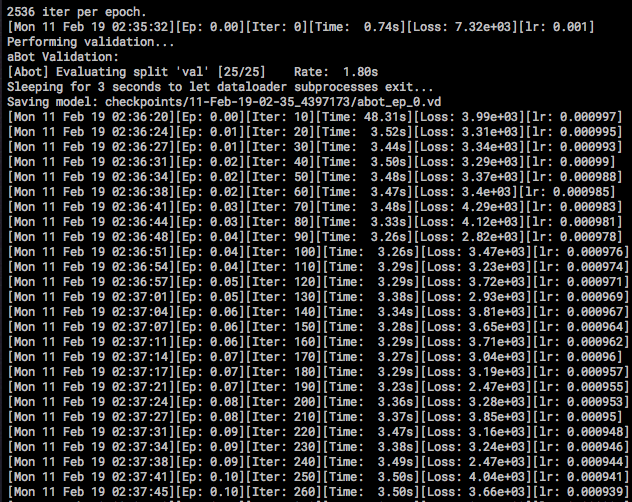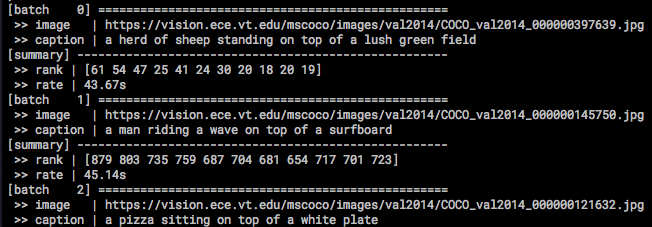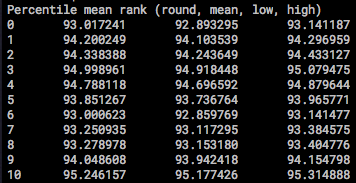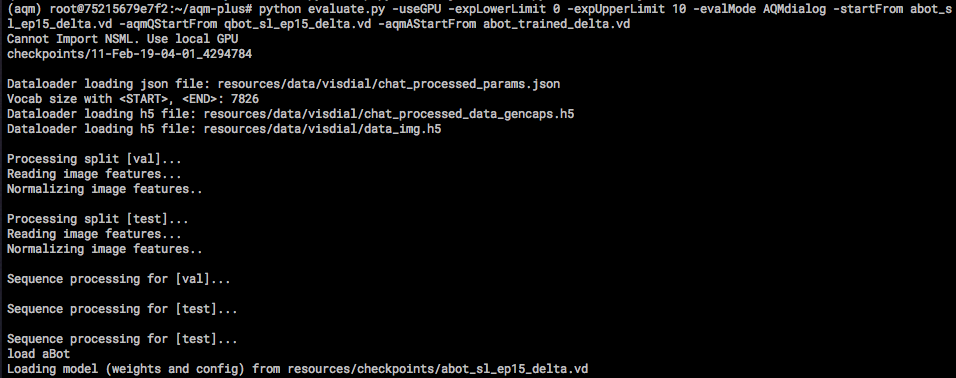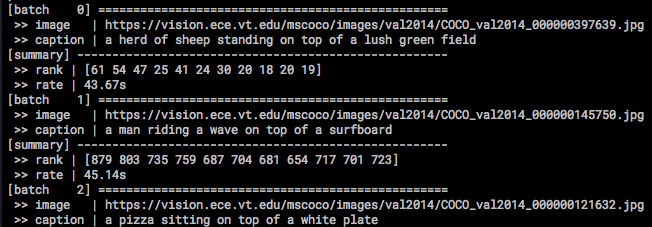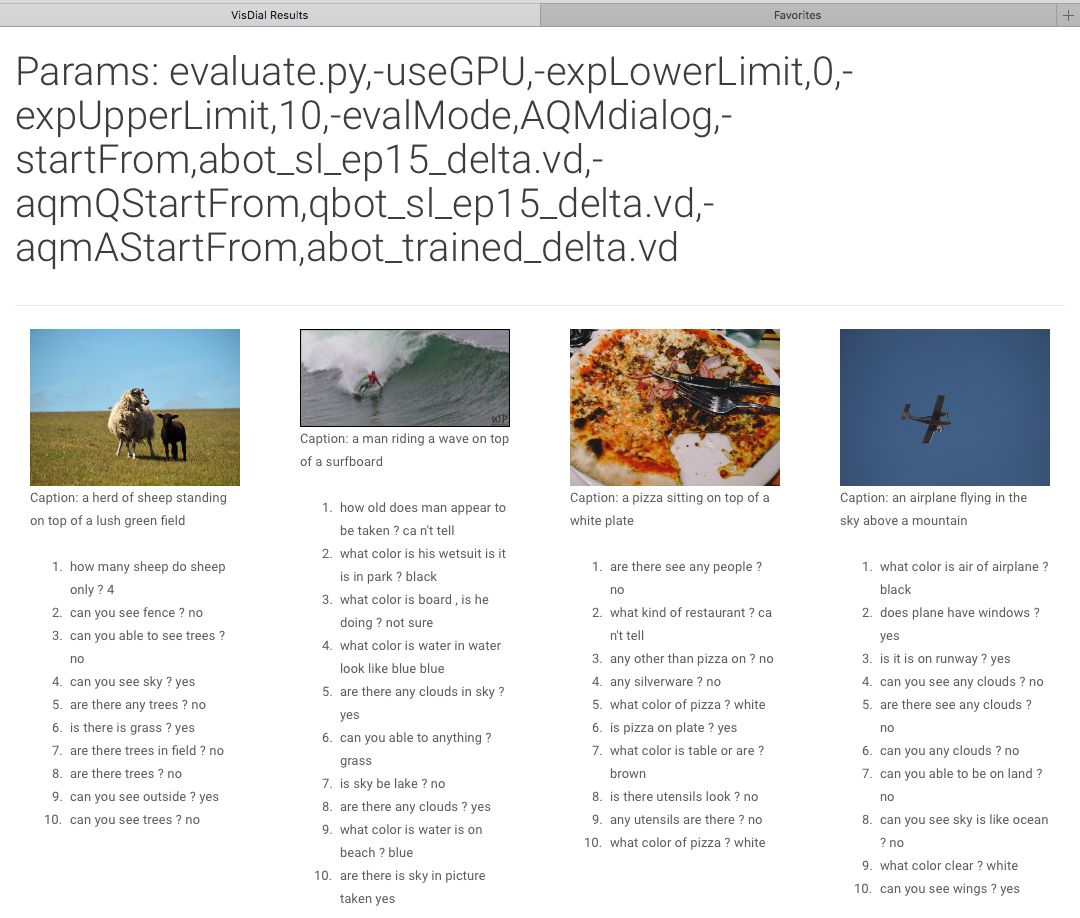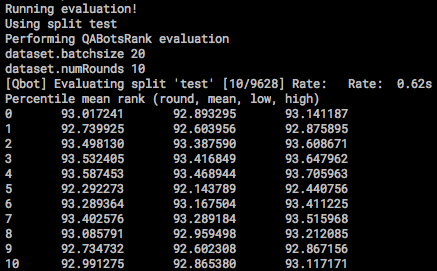PyTorch(v0.3.1) implementation of the paper:
Large-Scale Answerer in Questioner's Mind for Visual Dialog Question Generation
Sang-Woo Lee, Tong Gao, Sohee Yang, Jaejun Yoo, and Jung-Woo Ha
ICLR 2019
Answerer in Questioner’s Mind (AQM) [Lee et al., 2018] is an information-theoretic framework that has been recently proposed for task-oriented dialog systems. AQM benefits from asking a question that would maximize the information gain when it is asked. However, due to its intrinsic nature of explicitly calculating the information gain, AQM has a limitation when the solution space is very large.
To address this, we propose AQM+ that can deal with a large-scale problem and ask a question that is more coherent to the current context of the dialog. We evaluate our method on GuessWhich, a challenging task-oriented visual dialog problem, where the number of candidate classes is near 10K.
Our experimental results and ablation studies show that AQM+ outperforms the state-of-the-art models by a remarkable margin with a reasonable approximation. In particular, the proposed AQM+ reduces more than 60% of error as the dialog proceeds, while the comparative algorithms diminish the error by less than 6%. Based on our results, we argue that AQM+ is a general task-oriented dialog algorithm that can be applied for non-yes-or-no responses.
This code is based on the PyTorch implementation of Learning Cooperative Visual Dialog Agents using Deep Reinforcement Learning [Das & Kottur et al., 2017].
On top of the code for training the questioner and answerer bots described in [Das & Kottur et al., 2017], in supervised fashion and via deep reinforcement learning on the Visdial 0.5 dataset for the cooperative visual dialog task of GuessWhich, this repository contains code for training answerer bot in depA fashion of AQM+ and evaluating AQM+ questioner.
There are several important terms which are repeatedly used in the AQM+ paper. Those terms are also important in order to understand this guide. Although it should not be difficult to follow the guide if you have read the paper, here provided is a brief explanation for some of the important terms.
- Non-delta / Delta: Terms for different hyperparameter settings (See 4.1 of AQM+ paper)
- Non-delta: A hyperparameter setting that [Das & Kottur et al., 2017] used in their paper.
- Delta: A hyperparameter setting that [Das & Kottur et al., 2017] found and reported in their github repository, which makes much progress on their algorithm. It sets CELossCoeff to 1 and lrDecayRate to 0.999962372474343 during training.
- There is no difference between the two settings in terms of interpretability. Delta setting is just a configuration of hyperparameters where the difference with non-delta setting is that it uses a different weight on one of the loss functions (the model of Das & Kottur et al. (2017b) optimizes the weighted sum of different loss functions) and a different value for learning rate decay.
- indA / depA / trueA: Terms for different learning strategies of AQM framework. (See 3.4 of AQM+ paper)
- indA
- aprxAgen is trained from the training data.
- depA
- aprxAgen is trained from the questions in the training data and following answers obtained in the conversation between Qbot and Abot.
- trueA
- aprxAgen is the same as Agen, i.e. they share the same parameters.
- indA
We provide pretrained checkpoints for models from [Das & Kottur et al., 2017] and AQM+. All necessary checkpoints and data can be downloaded from here. Unzip resources.zip and put it under the root directory of this repository.
aqm-plus
|-- dialog_output
|-- eval_utils
|-- images
|-- resources
|-- checkpoints
|-- abot_rl_ep10.vd
|-- ...
|-- data
|-- visdial
|-- chat_processed_data.h5
|-- ...
|-- scripts
|-- utils
|-- visdial
...
- Pretrained Checkpoints (inside
resources/checkpoints/)- AQM+
- Delta
- qbot_sl_ep15_delta.vd
- SL-trained Qbot. Downloaded from the github repository of [Das & Kottur et al., 2017].
- In AQM+ setting, Used as Qgen of AQM+.
- abot_sl_ep15_delta.vd
- SL-trained Abot. Downloaded from the github repository of [Das & Kottur et al., 2017].
- In AQM+ setting, used as Abot, and used as aprxAgen of AQM+ for trueA.
- abot_trained_delta.vd
- SL-trained Abot, but with a different random seed.
- In AQM+ setting, used as aprxAgen of AQM+ for indA.
- aqmbot_depon_delta.vd
- Abot trained in depA manner.
- Trained from the questions in the training data and following answers obtained in the conversation between Qbot(qbot_sl_ep15_delta.vd) and Abot(abot_sl_ep15_delta.vd).
- In AQM+ setting, used as aprxAgen of AQM+ for depA.
- qbot_sl_ep15_delta.vd
- Non-delta
- qbot_sl_ep60.vd
- SL-trained Qbot. Downloaded from the github repository of [Das & Kottur et al., 2017].
- In AQM+ setting, Used as Qgen of AQM+.
- abot_trained_60.vd
- SL-trained Abot.
- In AQM+ setting, used as Abot, and used as aprxAgen of AQM+ for trueA.
- abot_sl_ep60.vd
- SL-trained Abot, but with a different random seed. Downloaded from the github repository of [Das & Kottur et al., 2017].
- In AQM+ setting, used as aprxAgen of AQM+ for indA.
- aqmbot_depon_trained_ep60.vd
- Abot trained in depA manner.
- Trained from the questions in the training data and following answers obtained in the conversation between Qbot(qbot_sl_ep60.vd) and Abot(abot_trained_60.vd).
- In AQM+ setting, used as aprxAgen of AQM+ for depA.
- qbot_sl_ep60.vd
- Delta
- [Das & Kottur et al., 2017]
- Delta
- SL-Q
- qbot_sl_ep15_delta.vd
- SL-trained Qbot. Downloaded from the github repository of [Das & Kottur et al., 2017].
- abot_sl_ep15_delta.vd
- SL-trained Abot. Downloaded from the github repository of [Das & Kottur et al., 2017].
- qbot_sl_ep15_delta.vd
- RL-QA
- qbot_rl_ep20_delta.vd
- RL-trained Qbot. Downloaded from the github repository of [Das & Kottur et al., 2017].
- abot_rl_ep20_delta.vd
- RL-trained Abot. Downloaded from the github repository of [Das & Kottur et al., 2017].
- qbot_rl_ep20_delta.vd
- SL-Q
- Non-delta
- SL-Q
- qbot_sl_ep60.vd
- SL-trained Qbot. Downloaded from the github repository of [Das & Kottur et al., 2017].
- abot_sl_ep60.vd
- SL-trained Abot. Downloaded from the github repository of [Das & Kottur et al., 2017].
- qbot_sl_ep60.vd
- RL-QA
- qbot_rl_ep20.vd
- RL-trained Qbot. Downloaded from the github repository of [Das & Kottur et al., 2017].
- abot_rl_ep20.vd
- RL-trained Qbot. Downloaded from the github repository of [Das & Kottur et al., 2017].
- qbot_rl_ep20.vd
- SL-Q
- Delta
- AQM+
As we extended the code of [Das & Kottur et al., 2017], our code is implemented in PyTorch v0.3.1.
-
Install Python 3.6.
-
Install PyTorch v0.3.1, preferably with CUDA - running with GPU acceleration is highly recommended.
-
Get the source code:
git clone https://github.com/naver/aqm-plus.git aqm-plus
-
Install requirements.
pip install -r requirements.txt
AQM+ basically uses the same training schemes as suggested in [Das & Kottur et al., 2017], except for the training of aprxAgen of AQM+ for depA setting. Therefore, for our experiments, we mainly used the pretrained models [Das & Kottur et al., 2017] provided, and additionally trained Abot for indA (with only the difference of random seed) and Abot for depA. All the necessary checkpoints can be downloaded from here, as explained above. However, if you want to train your own models, here is a brief guide.
Random seed can be set using -randomSeed <seed>.
Checkpoints for Qbot obtained by training can be used as either Qbot or Qgen of AQM+ Qbot. They are stored inside checkpoints/.
- Training Qbot
- Non-delta
python train.py -useGPU -trainMode sl-qbot -numEpochs 60
- Delta
python train.py -useGPU -trainMode sl-qbot -numEpochs 15 -CELossCoeff 1 -lrDecayRate 0.999962372474343
- Non-delta
Checkpoints for Abot obtained by training can be used as either Abot or aprxAgen of AQM+ Qbot. They are stored inside checkpoints/.
-
Training Abot
- Non-delta
python train.py -useGPU -trainMode sl-abot -numEpochs 60
- Delta
python train.py -useGPU -trainMode sl-abot -numEpochs 15 -CELossCoeff 1 -lrDecayRate 0.999962372474343
- Non-delta
-
Training aprxAgen of AQM+ Qbot for depA setting
- In order to train aprxAgen of AQM+ for depA setting, pretrained checkpoints for Qbot and Abot must be provided.
- Non-delta
python train.py -useGPU -trainMode aqmbot-dep -startFrom abot_trained_60.vd -qstartFrom qbot_sl_ep60.vd -numEpochs 60
- Delta
python train.py -useGPU -trainMode aqmbot-dep -startFrom abot_sl_ep15_delta.vd -qstartFrom qbot_sl_ep15_delta.vd -numEpochs 15 -CELossCoeff 1 -lrDecayRate 0.999962372474343
To train a non-delta Abot, run command python train.py -useGPU -trainMode sl-abot -numEpochs 60.
Preparation logs will be printed like this:
and then training logs will be printed.
Checkpoints will be saved at every epoch, under checkpoints/<trainingStartedTime>/.
Here provided are the commands to evaluate models of AQM+ or [Das & Kottur et al., 2017] as in AQM+ paper. We first give a list of commands to run the models and then describe specific options in more detail.
-
PMR
-
AQM+
-
Delta
-
indA
python evaluate.py -useGPU -expLowerLimit <lowerLimit> -expUpperLimit <upperLimit> -evalMode AQMBotRank -startFrom abot_sl_ep15_delta.vd -aqmQStartFrom qbot_sl_ep15_delta.vd -aqmAStartFrom abot_trained_delta.vd
-
depA
python evaluate.py -useGPU -expLowerLimit <lowerLimit> -expUpperLimit <upperLimit> -evalMode AQMBotRank -startFrom abot_sl_ep15_delta.vd -qstartFrom qbot_sl_ep15_delta.vd -aqmstartFrom aqmbot_depon_delta.vd
-
trueA
python evaluate.py -useGPU -expLowerLimit <lowerLimit> -expUpperLimit <upperLimit> -evalMode AQMBotRank -startFrom abot_sl_ep15_delta.vd -aqmQStartFrom qbot_sl_ep15_delta.vd -aqmAStartFrom abot_sl_ep15_delta.vd
-
-
Non-delta
- indA
python evaluate.py -useGPU -expLowerLimit <lowerLimit> -expUpperLimit <upperLimit> -evalMode AQMBotRank -startFrom abot_trained_60.vd -aqmQStartFrom qbot_sl_ep60.vd -aqmAStartFrom abot_sl_ep60.vd
- depA
python evaluate.py -useGPU -expLowerLimit <lowerLimit> -expUpperLimit <upperLimit> -evalMode AQMBotRank -startFrom abot_trained_60.vd -qstartFrom qbot_sl_ep60.vd -aqmstartFrom aqmbot_depon_trained_ep60.vd
- trueA
python evaluate.py -useGPU -expLowerLimit <lowerLimit> -expUpperLimit <upperLimit> -evalMode AQMBotRank -startFrom abot_trained_60.vd -aqmQStartFrom qbot_sl_ep60.vd -aqmAStartFrom abot_sl_ep60.vd
- indA
-
[Das & Kottur et al., 2017]
- Delta
- SL-Q
python evaluate.py -useGPU -expLowerLimit <lowerLimit> -expUpperLimit <upperLimit> -evalMode QABotsRank -qstartFrom qbot_sl_ep15_delta.vd -startFrom abot_sl_ep15_delta.vd
- RL-QA
python evaluate.py -useGPU -expLowerLimit <lowerLimit> -expUpperLimit <upperLimit> -evalMode QABotsRank -qstartFrom qbot_rl_ep20_delta.vd -startFrom abot_rl_ep20_delta.vd
- SL-Q
- Non-delta
- SL-Q
python evaluate.py -useGPU -expLowerLimit <lowerLimit> -expUpperLimit <upperLimit> -evalMode QABotsRank -qstartFrom qbot_sl_ep60.vd -startFrom abot_sl_ep60.vd
- RL-QA
python evaluate.py -useGPU -expLowerLimit <lowerLimit> -expUpperLimit <upperLimit> -evalMode QABotsRank -qstartFrom qbot_rl_ep20.vd -startFrom abot_rl_ep20.vd
- SL-Q
- Delta
-
-
-
Dialog
- AQM+
- Delta
- indA
python evaluate.py -useGPU -expLowerLimit <lowerLimit> -expUpperLimit <upperLimit> -evalMode AQMdialog -startFrom abot_sl_ep15_delta.vd -aqmQStartFrom qbot_sl_ep15_delta.vd -aqmAStartFrom abot_trained_delta.vd
- depA
python evaluate.py -useGPU -expLowerLimit <lowerLimit> -expUpperLimit <upperLimit> -evalMode AQMdialog -startFrom abot_sl_ep15_delta.vd -qstartFrom qbot_sl_ep15_delta.vd -aqmstartFrom aqmbot_depon_delta.vd
- trueA
python evaluate.py -useGPU -expLowerLimit <lowerLimit> -expUpperLimit <upperLimit> -evalMode AQMdialog -startFrom abot_sl_ep15_delta.vd -aqmQStartFrom qbot_sl_ep15_delta.vd -aqmAStartFrom abot_sl_ep15_delta.vd
- indA
- Non-delta
- indA
python evaluate.py -useGPU -expLowerLimit <lowerLimit> -expUpperLimit <upperLimit> -evalMode AQMdialog -startFrom abot_trained_60.vd -aqmQStartFrom qbot_sl_ep60.vd -aqmAStartFrom abot_sl_ep60.vd
- depA
python evaluate.py -useGPU -expLowerLimit <lowerLimit> -expUpperLimit <upperLimit> -evalMode AQMdialog -startFrom abot_trained_60.vd -qstartFrom qbot_sl_ep60.vd -aqmstartFrom aqmbot_depon_trained_ep60.vd
- trueA
python evaluate.py -useGPU -expLowerLimit <lowerLimit> -expUpperLimit <upperLimit> -evalMode AQMdialog -startFrom abot_trained_60.vd -aqmQStartFrom qbot_sl_ep60.vd -aqmAStartFrom abot_sl_ep60.vd
- indA
- Delta
- [Das & Kottur et al., 2017]
- Delta
- SL-Q
python evaluate.py -useGPU -expLowerLimit <lowerLimit> -expUpperLimit <upperLimit> -evalMode dialog -beamSize 5 -qstartFrom qbot_sl_ep15_delta.vd -startFrom abot_sl_ep15_delta.vd
- RL-QA
python evaluate.py -useGPU -expLowerLimit <lowerLimit> -expUpperLimit <upperLimit> -evalMode dialog -beamSize 5 -qstartFrom qbot_rl_ep20_delta.vd -startFrom abot_rl_ep20_delta.vd
- SL-Q
- Non-delta
- SL-Q
python evaluate.py -useGPU -expLowerLimit <lowerLimit> -expUpperLimit <upperLimit> -evalMode dialog -beamSize 5 -qstartFrom qbot_sl_ep60.vd -startFrom abot_sl_ep60.vd
- RL-QA
python evaluate.py -useGPU -expLowerLimit <lowerLimit> -expUpperLimit <upperLimit> -evalMode dialog -beamSize 5 -qstartFrom qbot_rl_ep20.vd -startFrom abot_rl_ep20.vd
- SL-Q
- Delta
- AQM+
python evaluate.py -useGPU -expLowerLimit <lowerLimit> -expUpperLimit <upperLimit>
- To perform an evaluation, run
evaluate.py. - To use GPU, specify
-useGPU. - Choose evaluation mode by setting
-evalMode <evalMode>. Evaluation modes are listed below. - Since AQM+ takes quite some inference time, it is recommended to run evaluations on parts of the whole dataset, by setting the lower limit and upper limit of test set images using
-expLowerLimit <lowerLimit>and-expUpperLimit <upperLimit>. Test set images inside the range[lowerLimit, upperLimit)are used. Limits can be a subrange of[0, 9628). (There are 9628 images in the test set.)
-
PMR of SL or RL (Abot and Qbot of [Das & Kottur et al., 2017])
-evalMode QABotsRank
-
PMR of AQM+
-evalMode AQMBotRank
-
Dialog visualization of SL or RL (Abot and Qbot of [Das & Kottur et al., 2017])
-evalMode dialog -beamSize 5- [Das & Kottur et al., 2017] uses beam size of 5 as default.
-
Dialog visualization of AQM+
-evalMode AQMdialog
resources/ is used as the root data directory if no option is given and the directory exists.
If you want, it is okay to change the directory name to data/. The program will still run fine without the need of additional options.
If you want to change the root data directory to something other than resources/ or data/, use -dataRoot <directory>.
run nsml -d <dataset> -e evaluate.py -a "<options>" would automatically set the paths of data and checkpoints to those inside <dataset>. No additional options are necessary.
Use aqm_all as dataset if you don't want to upload your own.
-
Delta
-
indA
-
-startFrom abot_sl_ep15_delta.vd-aqmQStartFrom qbot_sl_ep15_delta.vd-aqmAStartFrom abot_trained_delta.vd
-
-
depA
-
-startFrom abot_sl_ep15_delta.vd-qstartFrom qbot_sl_ep15_delta.vd-aqmstartFrom aqmbot_depon_delta.vd
-
-
trueA
-
-startFrom abot_sl_ep15_delta.vd-aqmQStartFrom qbot_sl_ep15_delta.vd-aqmAStartFrom abot_sl_ep15_delta.vd
-
-
-
Non-delta
-
indA
-
-startFrom abot_trained_60.vd-aqmQStartFrom qbot_sl_ep60.vd-aqmAStartFrom abot_sl_ep60.vd
-
-
depA
-
-startFrom abot_trained_60.vd-qstartFrom qbot_sl_ep60.vd-aqmstartFrom aqmbot_depon_trained_ep60.vd
-
-
trueA
-
-startFrom abot_trained_60.vd-aqmQStartFrom qbot_sl_ep60.vd-aqmAStartFrom abot_sl_ep60.vd
-
-
- Guesser (Figure 3)
- This does not calculate information gain; it uses beam search of beam size 1 to make the question.
-onlyGuesser 1
- No Caption (Figure 4a, 8a)
- Zero Caption
-zeroCaption 1
- Random Caption
-randomCaption 1
- Zero Caption
- Random Candidate Answer (Figure 4b)
-randA 1 -resampleEveryDialog 1
- Number of Q (Figure 5b)
-numQ <numberOfQuestions>
- Number of A (Figure 5c)
-numA <numberOfAnswers>
- number of C (Figure 5d)
-numImg <numberOfImages>
- AQM+'s Qinfo + SL's Qscore (Figure 9)
-slGuesser 1
- gen1Q (Figure 10)
-gen1Q <numberOfQuestions>
- randQ (Figure 11)
-randQ 1 -resampleEveryDialog 1
- No History (Figure 12)
-noHistory 1
By default, the program shows the conversation between Qbot and Abot while calculating the PMR. To disable this, set -showQA 0.
To save logs for analysis, e.g. image-wise and turn-wise rank/qa pair/image url, set -saveLogs 1.
To evaluate the PMR of delta indA model of test set images from 0 to 9, run command python evaluate.py -useGPU -expLowerLimit 0 -expUpperLimit 10 -evalMode AQMBotRank -startFrom abot_sl_ep15_delta.vd -aqmQStartFrom qbot_sl_ep15_delta.vd -aqmAStartFrom abot_trained_delta.vd .
Preparation logs will be printed like this:
evaluation logs will be printed like this:
After the evaluation, PMR will be printed.
To evaluate the PMR of delta indA model of test set images from 0 to 9, run command python evaluate.py -useGPU -expLowerLimit 0 -expUpperLimit 10 -evalMode AQMBotRank -startFrom abot_sl_ep15_delta.vd -aqmQStartFrom qbot_sl_ep15_delta.vd -aqmAStartFrom abot_trained_delta.vd
Preparation logs will be printed like this:
and then the evaluation logs will be printed.
When the evaluation is done, the dump result will be saved in dialog_output/results/ as results.json.
To see the dumped dialogs, move into dialog_output/ and run python -m http.server <port>.
Then access <server_ip>:<port> on your web browser.
To evaluate the PMR of Delta SL-Q of [Das & Kottur et al., 2017] of test set images from 0 to 9, run command python evaluate.py -useGPU -expLowerLimit 0 -expUpperLimit 10 -evalMode QABotsRank -qstartFrom qbot_sl_ep15_delta.vd -startFrom abot_sl_ep15_delta.vd.
After the evaluation, the PMR of test set images [0:10) will be printed like this.
If you use this code as part of any published research, please cite S.-W. Lee, T. Gao, S. Yang, J. Yoo, and J.-W. Ha, Large-Scale Answerer in Questioner's Mind for Visual Dialog Question Generation, 2019.
This code is based on the github repository
which is the official PyTorch implementation of
We would like to thank the authors of the work.
Copyright (c) NAVER Corp. Licensed under BSD 3-clause
For help or issues regarding the code, please submit a github issue.
Reading the readme of VisDial-RL-PyTorch would help as well.

